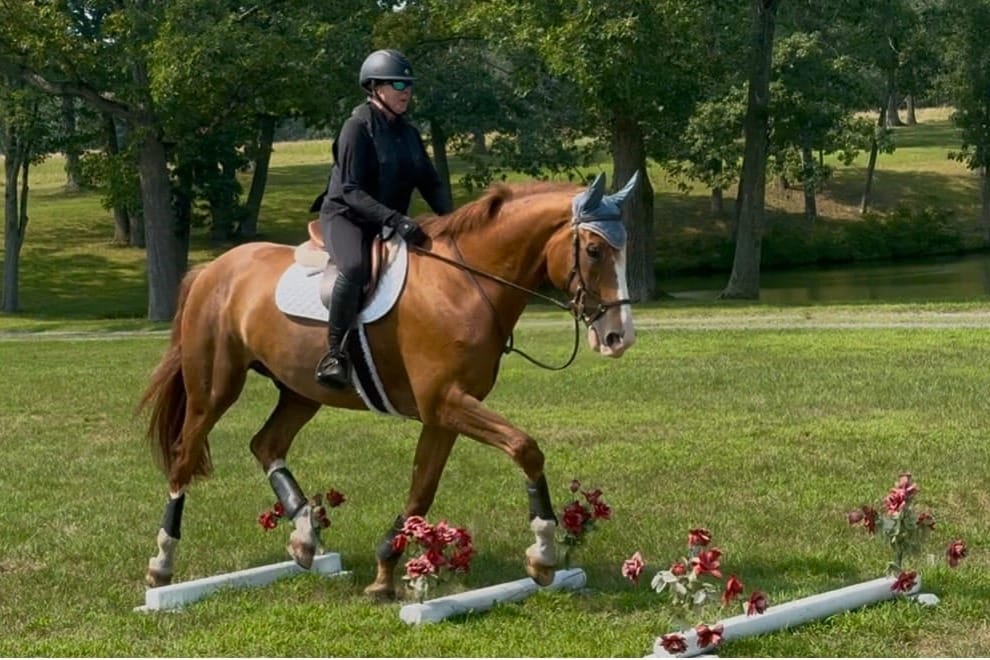Cavaletti Work: Precision Training That Pays Off
Cavaletti may look simple, but these ground poles can build strength, rhythm, balance, and communication between you and your horse. Whether you're prepping for dressage or just want a sharper ride, cavaletti work adds variety and results without adding strain.

If you’ve been riding long enough, chances are you’ve trotted over a few ground poles without giving them much thought. But cavaletti work is far more than a warm-up gimmick, it’s a sophisticated training tool that can sharpen your horse’s athleticism, polish your aids, and keep schooling sessions fresh. For seasoned riders, cavaletti can be the key to unlocking even more brilliance in the arena.
What are Cavaletti?
A cavaletti is one of the simplest yet most versatile tools in a rider’s training kit. At its core, it’s just a rail set slightly off the ground, either on blocks, standards, or special X-shaped ends that allow you to raise or lower the height. But don’t let the simplicity fool you. Cavaletti can be used at the walk, trot, and canter to develop rhythm, balance, strength, and coordination. From young horses learning where to put their feet to seasoned competitors fine-tuning precision, cavaletti work offers benefits for every discipline and every level of rider.
Why Cavaletti Belong in Every Rider’s Toolkit
1. Strength Without Strain
Cavaletti is a low-impact exercise that is designed to strengthen your horse, it’s like doing physical therapy. By stepping over raised rails, your horse engages the topline, strengthens the hindquarters, and improves flexion in the joints. Regular work can also improve posture and balance, especially in horses that tend to hollow out or lean on the forehand.
2. A Tune-Up for Rhythm and Cadence
At trot and canter, cavaletti force both horse and rider to lock into a consistent tempo. You’ll feel instantly if your horse is rushing, dragging, or losing straightness. Ingrid Klimke, who quite literally wrote the book on cavaletti, recommends weekly sessions to enhance cadence, balance, and self-carriage.
3. Mental Gymnastics for Horse and Rider
Each pass over cavaletti is a puzzle. Your horse must pay attention, engage their brain, and think about foot placement. As the rider, you sharpen your timing, accuracy, and ability to influence stride length. It’s a brilliant way to build communication and trust while also teaching your horse about footwork.
4. Cross-Training Power
Whether your goals are upper-level dressage, hunters, jumpers, or eventing, cavaletti work translates across disciplines. Top event riders use it to build agility and confidence, while dressage riders rely on it to improve elasticity and reach in the gaits. Hunter and jumper riders use it to increase their horses’ fitness and work on adjustability.
How to Set Cavaletti
The magic of cavaletti lies in correct spacing. Too short and your horse stumbles. Too long and rhythm disappears. Use these guidelines as a starting point, adjusting for your horse’s stride and level of training:
- Walk: 2.5–3 feet (0.75–0.9 m) apart.
- Trot: 4–4.5 feet (1.2–1.4 m) apart.
- Canter (bounce): 9–11 feet (2.7–3.3 m) apart.
Pro Tips for Setup:
- Start Low, Build Up: Begin with poles flat on the ground. Once your horse is confident, you can graduate to raised cavaletti. Lift them up 6-12 inches using blocks or standards if you don’t have the permanent ones.
- Straight Lines for Clarity: Use 3-5 rails in a row for rhythm and consistency.
- Circles and Fans for Suppleness: Place cavaletti on a curve or in a fan pattern to encourage bend and inside hind engagement.
- Mix It Up: Alternate between raised and flat poles, or create figure-eight and serpentine patterns for added challenge. Add flowers or other props to keep your horses thinking.
For advanced sessions, consider a “trot-canter-trot” combination, where trot cavaletti are followed by a canter line. This transitions your horse between collection and extension, testing adjustability.
A Sample Session for the Experienced Rider
- Warm-Up: Walk over single poles on a long rein.
- Trot Lines: Ride a straight line of four raised trot cavaletti, focusing on steady rhythm.
- Circle Work: Add four trot poles on a 20 m circle to promote suppleness.
- Canter Bounces: Use three cavaletti at bounce distance (9–10 feet) to build hindquarter strength.
- Combination: Alternate trot and canter lines for transitions and adjustability.
- Cool-Down: End with a relaxed walk over poles, letting your horse stretch.
Final Thoughts
Cavaletti work is deceptively simple but endlessly valuable. It’s not just about “stepping over poles”—it’s about refining communication, developing athleticism, and keeping training engaging. Think of cavaletti as your horse’s version of Pilates: small, thoughtful exercises that create big results over time. Whether you’re chasing clean jumper rounds, supple dressage movements, or smoother hunter trips, cavaletti can help you get there—with less strain and more brilliance.
The beauty of cavaletti is in its versatility. It meets every horse and rider where they are, offering benefits whether you’re polishing an FEI test, building up a young horse’s foundation, or simply looking to add variety to your flatwork. It sharpens your eye as a rider, makes your aids clearer, and gives your horse the tools to carry themselves with balance and power. Even better, it keeps schooling sessions fresh, so your horse stays mentally engaged and physically challenged without burnout.
In the end, cavaletti are proof that sometimes the simplest tools yield the most profound results. With a few rails on the ground, you can transform the way your horse moves, thinks, and responds. Over time, those small adjustments add up to smoother rounds, healthier bodies, and a stronger partnership in the saddle. So next time you’re setting up the arena, don’t overlook those poles, they just might be the key to your horse’s next big breakthrough.
Want to talk more about cavaletti? Join the conversation on TurnoutHQ!
SOURCES
https://madbarn.com/cavaletti-exercises-for-horses
https://practicalhorsemanmag.com/training/cavalletti-training-for-every-horse-and-discipline

